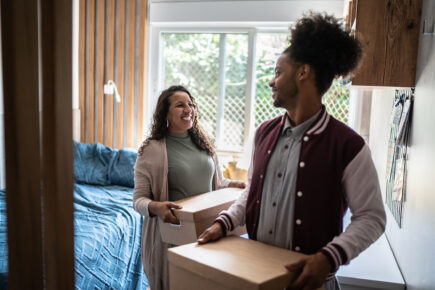Whether you’re relocating for work, going through a separation or juggling two mortgages, needing to sell your home quickly can add pressure to an already stressful process. However, it’s entirely doable with clear communication and realistic goals.
The number of days a home is on the market depends on local inventory and buyer demand. Single-family homes sat on the market for a median of 23 days in Toronto, 24 days in Edmonton and 28 days in Calgary during the third quarter of 2025, according to the Canadian Real Estate Association.
If you’re looking to sell in a hurry, find a real estate agent with solid marketing chops who has a track record of getting deals done quickly.
1. Understand what ‘fast’ really means
If all goes smoothly, you can cut the typical time needed to sell in half — but that still means a process that takes at least six weeks.
Typically, “a start to finish could range from 90 to 120 days, depending on the closing date for the buyer,” says Andre Chin, a real estate broker with Keller Williams Innovation Realty in Kitchener, Ontario.
Chin notes that it takes about two weeks to get a home decluttered, staged and photographed, and another two weeks to sell it. And with a 60-day close after an offer is accepted, expect the entire process to wrap up within 90 days, he adds.
But for truly motivated sellers, “a quicker closing could shorten this down to 45 to 60 days total,” Chin says. Anything “under 45 days starts to become unreasonable,” he adds.
2. Invest in presentation (even in a pinch)
Professional staging, top-notch photos and prepping your home to be move-in ready aren’t optional if you want to sell it fast.
Partially staging a home can run $1,500 to $3,000 per month while a full staging can cost between $2,500 and $6,000 per month, according to Astra Staging in Mississauga, Ontario. Fees vary based on your home’s size and whether it’s occupied or vacant.
At a minimum, Chin recommends investing in a staging consultation (which can run $200 to $600) to get guidance on how to do it yourself. Additionally, your agent might offer an AI photo staging service at a much lower cost ($10 to $35 per photo). However, your property listing must make it clear the photos are digitally staged.
If full staging isn’t in your budget, consider upgrades like fresh paint and carpet, fixing minor cosmetic issues and decluttering personal items (like pictures, collectibles and knickknacks). Pack up and store everything you’re not actively using out of sight, especially on countertops and other surfaces.
Doug Cabral of Royal LePage Benchmark in Calgary warns that rushing to market before your home is ready can actually backfire.
“If you’re not ready, you could just extend all of that time (and more) on market,” he says.
3. Price for speed
It may be a tough pill to swallow for sellers, but strategic underpricing works, both real estate agents say. Cabral recommends pricing 2% to 3% below market value, while Chin suggests a bolder 10% shave off the top to speed up the process.
This pricing strategy is all about creating urgency — and playing with buyers’ psychology, Cabral says.
“Buyers always want to know their homes can be worth more next year than it was this year,” Cabral says. “When you come to market a bit lower than that, they feel like they have some room.”
4. Hold concessions for negotiations
You might be tempted to offer concessions on your listing, but both Cabral and Chin agree this is a no-no.
Instead, wait until you’re at the negotiating table with a serious buyer so you can get the deal across the finish line, Chin recommends.
And if your home needs work, factoring those costs into your asking price upfront (and communicating why) is better than offering seller concessions, Cabral advises.
5. Don’t fixate on the highest bid
When multiple offers start rolling in, the highest one isn’t always the right choice. A fast sale depends on certainty, not just the highest offer price.
“One of the best ways to look at an offer that is likely to get to the finish line is the amount of deposit the client is willing to provide, as well as minimal contingencies,” Chin notes. “Serious buyers who want the property are more likely to show that in the beginning.”
Cabral echoes this advice.
“Sometimes, the best price isn’t the best offer, because somebody will overpay for something that they need a whole litter of conditions on,” he says.
6. If the home isn’t selling, diagnose the problem
If your perfectly staged, well-marketed home sits without offers, price is usually the culprit.
“Three things sell homes: price, location and condition of the home,” Chin explains. “You can’t change the location, and if you have done everything to present the home in a condition that a buyer may find desirable, then the only thing left is to price it at a price that will sell.”
“Remember the home is only worth what a buyer is willing to pay,” he adds.

Switching Mortgages: Guide to Changing Your Loan or Lender
Switching mortgages is possible at any time during the course of your term, but there are things to watch out for, like prepayment fees.

Porting or Transferring a Mortgage
Porting a mortgage applies an existing mortgage contract to a new home purchase. Porting can be less expensive than breaking a mortgage.

Moving Home To Save Money? Think It Through
Moving back home can be an effective way to save money, but it’s important to have a goal — and your next step in mind — before boxing up your stuff.

DIY Home Selling: 7 Must-Read Tips from People Who’ve Done It
The for-sale-by-owner path isn’t right for everyone — it requires more of your time and energy — but it could lead to more profit.
